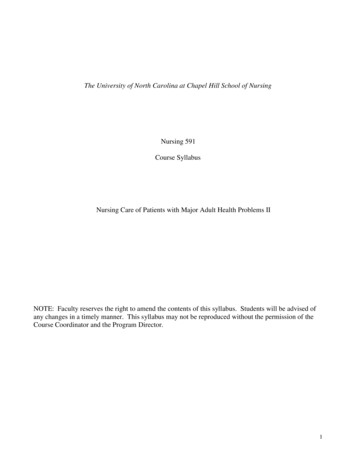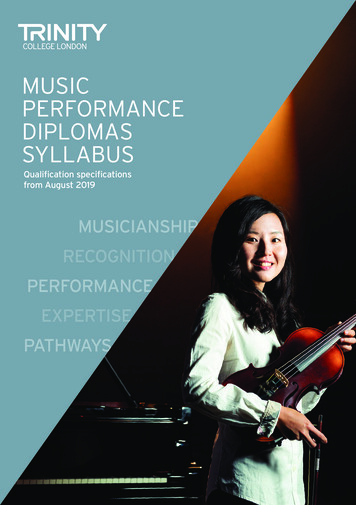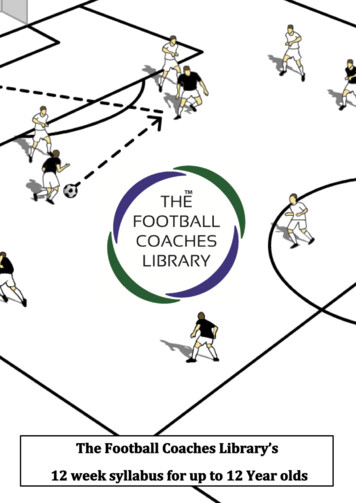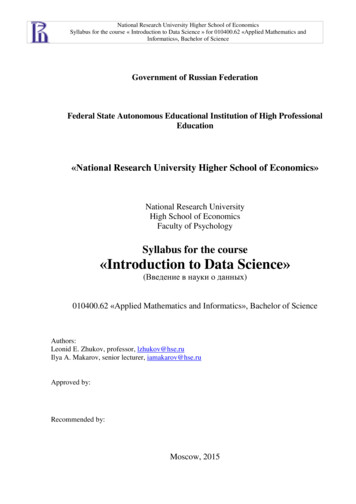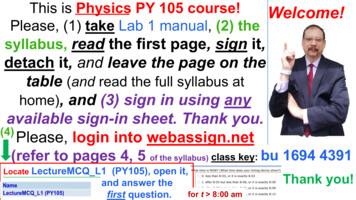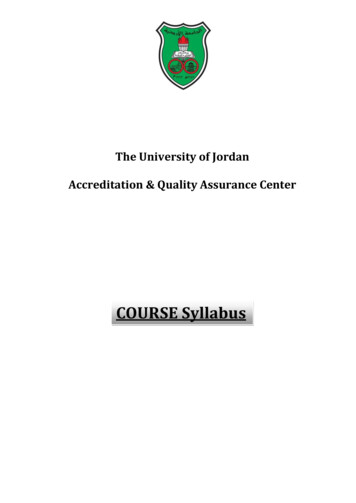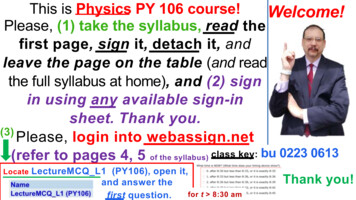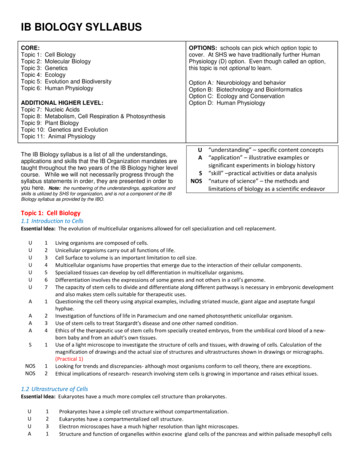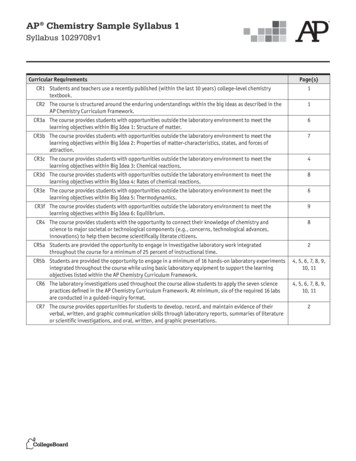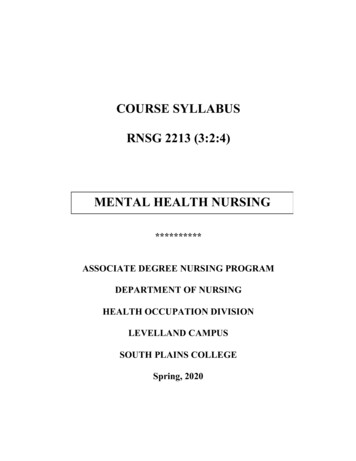
Transcription
COURSE SYLLABUSRNSG 2213 (3:2:4)MENTAL HEALTH NURSING**********ASSOCIATE DEGREE NURSING PROGRAMDEPARTMENT OF NURSINGHEALTH OCCUPATION DIVISIONLEVELLAND CAMPUSSOUTH PLAINS COLLEGESpring, 2020
SOUTH PLAINS COLLEGE ASSOCIATEDEGREE NURSING PROGRAMRNSG 2213MENTAL HEALTH NURSINGTable of ContentPageCOURSE SYLLABUS.1Course Description.1Course Learning Outcomes.1Educational Objectives 2Course Competencies.3Academic Integrity.3SPECIFIC COURSE/INSTRUCTOR REQUIREMENTS .3Required Text.3Attendance Policy .4Assignment Policy .5Grading Policy .6Course Grade Worksheet .7Special Requirements.8ACCOMODATIONS.8SCANS .10COURSE OUTLINE .11MODULES .19III -Foundation of Mental Health (Psychosocial Nursing) .20Caring and Healing with Clients and Families Experiencing Psycho-Socio-CulturalSpiritual Dysfunction .37Campuses:1
LevellandRNSG 2213COURSE SYLLABUSCOURSE TITLE:RNSG 2213 Mental Health NursingINSTRUCTOR:Lourie Winegar MSN, RN, PMHNP-BC2
RNSG 2213OFFICE LOCATION, PHONE/E-MAIL:Lourie WinegarOFFICE HOURS:894-9611, ext 2030lwinegar@southplainscollege.eduPosted on each instructor’s doorSOUTH PLAINS COLLEGE IMPROVES EACH E DESCRIPTION AND END-OF-COURSEOUTCOMESRNSG 2213 integrates the principles and concepts of mental health, psychopathology, andtreatment modalities as they relate to providing nursing care to patients and their familiessuffering from mental illnesses. The course is designed to provide the learner with the basicknowledge and skills necessary to function within the four roles of nursing which include:Member of the profession; Provider of patient-centered care; Patient safety advocate; andMember of the health care team. RNSG 2213 is a foundational course which utilizes classroominstruction, active learning, and role-play as tools to educate the student about nursing roles asthey apply to patients/families across the life span and to persons who are receiving care asinpatients in psychiatric facilities as well as in various community settings.At the end of the course, the student will demonstrate proficiency in the following areas as theyrelate to providing care for patients and families that are experiencing mental health problems.The student will be able to explain the roles of the professional nurse in caring for patients andfamilies experiencing mental health problems. Additionally, the student will have an applicablefoundation for therapeutic communication as demonstrated by submitting a self-critiquedtherapeutic conversation that they have had which follows a specified format with facultyfeedback. The student will demonstrate critical thinking and use a systemized problem-solvingprocess for providing care to persons and their families that are experiencing mental healthproblems. Students who successfully pass course requirements for RNSG 2213 are able toenroll in RNSG 2261, which is a clinical-based nursing course.4
A.COURSE COMPETENCIESRNSG 22131.Successful completion of this course requires a grade of “C” or better,satisfactory total grade point average on examinations and written assignments,satisfactory achievement of unit outcomes, completion of standardized tests asapplicable to the curriculum, and regular classroom/clinical attendance. Uponsuccessful completion of this course, each student will have demonstratedaccomplishment of the level outcomes for the course, through a variety ofmodes (prelims, role play, case studies, individual presentations, grouppresentations, lab performance).B.ACADEMIC INTEGRITY1.Refer to the SPC college catalog. Refer to the SPC ADNP nursingstudent2.Handbook: “Honesty Policy.”C.SCANS and FOUNDATION SKILLS1.Scans and foundation skills found within this course, are listed below theunit title2.(and above the content column) of each unit presented.D.VERIFICATION OF WORKFORCE COMPETENCIES1.No external learning experiences provided but learning experiences inlab provide setting in which student applies workplace competencies.Successful completion of the Entry Level Competency statements at the levelspecified by the course (Level Objectives) will allow the student to continue toadvance within the program. Upon successful completion of the program,students will be eligible to take the state board exam (NCLEX) for registerednurse licensure.II.SPECIFIC COURSE/INSTRUCTOR REQUIREMENTS5
A.RNSG 2213REQUIRED TEXTBOOKS1. Videbeck, Sheila L. (Most recent edition). Psychiatric Mental HealthNursing: Philadelphia, PA: Lippincott.2. Syllabus: RNSG 2213 (Mental Health Nursing)3. Nurse Practice Act4. ATI Text and online resources for Mental Health Nursing5. Access to BlackboardB.ATTENDANCE POLICY:1. Punctual and regular class attendance, as stated in the SPC and ADNHandbook, is required of all students attending SPC. There are no excusedabsences. Class hours 9 am – 12 pm or 3pm-See course calendar.a)Lecture attendance is mandatory. The student will be dropped fromRNSG 2213 if they accumulate 9 hours in absences (This is three classmeetings).C.b)Tardiness is disruptive and will be cumulative towards an absence.c)All absences, partial or complete, are cumulative.ASSIGNMENT POLICY1. All required work must be in on time in order that the student may benefitfrom the corrections and study for future examinations. Assigned outside workis due on the dates specified by the instructor. Assignments turned in later thanthe due date will not be accepted unless the student clears the circumstanceswith the instructor. The assignment will be docked 5 points for each day that itis past due, including weekends and holidays. All work is due at the beginningof class and must be in the required format. Work turned in after the date duemust be initialed and dated by another nursing department faculty or office staffmember and placed in the instructor’s mail box in the Nursing DepartmentOffice located on the Levelland campus. Assignments turned in beyond oneweek from the due date will not be graded and the student will receive azero.6
RNSG 22132. Students should retain a photocopy or computer-accessible file of allassignments turned in.3. Assignments are not accepted by email—a “hard” copy is the required format.7
SOUTH PLAINS COLLEGE ASSOCIATEDEGREE NURSING PROGRAMEDUCATIONAL OBJECTIVESRNSG 2213The educational outcomes of this program will prepare the graduate to function within thethree roles of nursing identified in the conceptual framework and philosophy. These rolesare provider of care, manager/coordinator of care, and member of the profession.Functioning within the three roles, the graduate of this program will be able to:PROVIDER OF CARE:1.Integrate theoretical concepts with nursing knowledge and skills to meet the basicneeds of clients, families, and/or groups throughout the life span in a variety ofsettings.2.Integrate the five steps of the nursing process into nursing practice.3.Communicate and collaborate effectively with clients, families, and/or groupsin a variety of settings.4.Provide safe, cost effective nursing care in collaboration with members of thehealth care team using critical thinking, problem solving, and the nursing process ina variety of setting through direct care, assignment, or delegation of care.5.Integrate principles of teaching-learning in providing information to clients, families,and/or groups regarding promotion, maintenance, and restoration of health or theprocess of death and dying.6.Evaluate clinical data, current literature, and client/family/community responsesand outcomes to therapeutic interventions in order to make appropriate nursingpractice decisions.MANAGER/COORDINATOR OF CARE:1.Function within the organizational framework of various healthcare settings.2.Evaluate the effectiveness of community resources in the delivery of healthcare to clients, families, and/or groups.3.Coordinate the health care team in delivering care to clients, families, and/or groups.4.Coordinate appropriate referral sources to meet the needs of clients, families,and/or groups.5.Utilize critical thinking and problem solving skills in prioritizing, managementand coordination of all aspects of care.8
Plagiarism DeclarationDepartment of NursingSouth Plains CollegeRNSG 2213By signing this plagiarism declaration I acknowledge that I have received a copy of the honestypolicy and been made aware that the penalty for plagiarism is dismissal from the program.Examples of student plagiarism Copying material without quotes, in-text citations, and/or referencing Paraphrasing content without in-text citation and/or referencing Copying ideas, words, answers, exams, or shared work from others when individualwork is required Using another’s paper in whole or in part Allowing another student to use one’s work Claiming someone else’s work is one’s own Resubmitting one’s own coursework, when original work is required (self-plagiarism) Falsifying references or bibliographies Getting help from another person without faculty knowledge or approval Purchasing, borrowing, or selling content with the intent of meeting an academicrequirement for oneself or others9
RNSG 2213D. GRADING POLICY (Refer to SPC ADNP Nursing Student Handbook GradingSystem)1. Students may review an exam by making an individual appointment with theinstructor.A student must communicate with one of the course instructors if they areunable to take an exam on a scheduled day. If there is no communication byexam, a “zero” will be given.Alternate exams may be given as makeup exams.2. A grade of 77% must be earned to pass RNSG 2213.E. SPECIAL REQUIREMENTS1. Skills Laboratory Component:a.Lab grade is incorporated into course work. See grade worksheet.b.Students are expected to participate in all class and lab activities.c.The skill laboratory component serves the following functions:To provide the opportunity for students to practice their skills prior toclinical practice of those skills. The nursing faculty expects the nursingstudent to develop safety and a beginning level of proficiency withprocedures by utilizing the college laboratory. This will minimize studentanxieties in the clinical setting and maximize positive productionoutcomes for both the client and the nursing student. Professionalbehavior is expected in class and in lab. There is a correlation in studentbehavior in class and lab with clinical performance.Required skills will be reviewed and demonstrated during class time.F. ACCOMODATIONS4.1.1.1 Diversity Statement:In this class, the teacher will establish and support an environment that values andnurtures individual and group differences and encourages engagement andinteraction. Understanding and respecting multiple experiences and perspectiveswill serve to challenge and stimulate all of us to learn about others, about thelarger world and about ourselves. By promoting diversity and intellectualexchange, we will not only mirror society as it is, but also model society as itshould and can be.4.1.1.2 Disabilities Statement:10
RNSG 2213Levelland CampusStudents with disabilities, including but not limited to physical, psychiatric, orlearning disabilities, who wish to request accommodations in this class shouldnotify the Disability Services Office early in the semester so that theappropriate arrangements may be made. In accordance with federal law, astudent requesting accommodations must provide acceptable documentationof his/her disability to the Disability Services Office. For more information,call or visit the Disability Services Office at Levelland Student Health &Wellness Center 806-716-2577, Reese Center (also covers ATC) Building 8:806-716-4675, Plainview Center Main Office: 806-716-4302 or 806-2969611, or the Health and Wellness main number at 806-716-2529.Reese Center and the Byron Martin Advanced Technology Center (ATC)Students with disabilities, including but not limited to physical, psychiatric, orlearning disabilities, who wish to request accommodations in this class shouldnotify the Special Services Office early in the semester so that the appropriatearrangements may be made.In accordance with federal law, a student requesting accommodations must provideacceptable documentation of his/her disability to the Coordinator of Special Services. Formore information, call or visit the Special Services Office in rooms 809 and 811, ReeseCenter Building 8, 885-3048 ext. 4654.11
RNSG 2213COURSE GRADE WORKSHEETRNSG 22131. Four (4) Major Tests 55%a. Test #1b. Test #2c. Test #3d. Test #4i. Total Points on 4 testsii. Average after 4 testsx.55 2. Participation grades and quizzes 15%3. Communication Process 5%a. Total Points4. ATI Test 5%a. Below Level 1 b. Level 1 c. Level 2 d. Level 3 5. Final Exam 20%a. Final Exam Gradex.05 x.05 x.20 6. Total GradeMUST HAVE TOTAL OF 77 POINTS TO PASSStudents with a B average on Major Tests and evidence of no absences will be exempted fromthe Final Exam. Major tests will then comprise 75% of the course grade. Passing is 77 or better.12
SCANS COMPETENCIESRNSG 2213RESOURCES: Identifies, organizes, plans and allocates resources.TIME--Selects goal--relevant activities, ranks them, allocates time, and prepares and follows schedules.MONEY--Uses or prepares budgets, makes forecasts, keeps records, and makes adjustments to meet objectivesMATERIALS & FACILITIES-Acquires, stores, allocates, and uses materials or space efficiently.HUMAN RESOURCES--Assesses skills and distributes work accordingly, evaluates performances and providesfeedback.INFORMATION--Acquires and Uses InformationC-5Acquires and evaluates information.C-6Organizes and maintains information.C-7Interprets and communicates information.C-8Uses computers to Process information.INTERPERSONAL--Works With OthersC-9Participates as members of a team and contributes to group effort.C-10Teaches others new skills.C-11Serves clients/customers--works to satisfy customer's expectations.C-12Exercises leadership--communicates ideas to justify position, persuades and convinces others, responsibly challengesexisting procedures and policies.C-13Negotiates-Works toward agreements involving exchanges of resources resolves divergent interests.C-14Works with Diversity-Works well with men and women from diverse backgrounds.SYSTEMS--Understands Complex InterrelationshipsC-15Understands Systems--Knows how social, organizational, and technological systems work and operates effectively withthemC-16Monitors and Correct Performance-Distinguishes trends, predicts impacts on system operations, diagnoses systems'performance and corrects malfunctions.C-17Improves or Designs Systems-Suggests modifications to existing systems and develops new or alternative systems toimprove performance.TECHNOLOGY--Works with a variety of technologiesC-18Selects Technology--Chooses procedures, tools, or equipment including computers and related technologies.C-19Applies Technology to Task-Understands overall intent and proper procedures for setup and operation of equipment.C-20Maintains and Troubleshoots Equipment-Prevents, identifies, or solves problems with equipment, including computersand other technologies.C-1C-2C-3C-4FOUNDATION SKILLSBASIC SKILLS--Reads, writes, performs arithmetic and mathematical operations, listens and speaksF-1Reading--locates, understands, and interprets written information in prose and in documents such as manuals, graphs,and schedules.F-2Writing-Communicates thoughts, ideas, information and messages in writing, and creates documents such as letters,directions, manuals, reports, graphs, and flow charts.F-3Arithmetic--Performs basic computations; uses basic numerical concepts such as whole numbers, etc.F-4Mathematics--Approaches practical problems by choosing appropriately from a variety of mathematical techniques.F-5Listening--Receives, attends to, interprets, and responds to verbal messages and other cues.F-6Speaking--Organizes ideas and communicates orally.THINKING SKILLS--Thinks creatively, makes decisions, solves problems, visualizes, and knows how to learn andreasonF-7Creative Thinking--Generates new ideas.F-8Decision-Making--Specifies goals and constraints, generates alternatives, considers risks, and evaluates and choosesbest alternative.F-9Problem Solving--Recognizes problems and devises and implements plan of action.F-10Seeing Things in the Mind's Eye--Organizes and processes symbols, pictures, graphs, objects, and other information.F-11Knowing How to Learn--Uses efficient learning techniques to acquire and apply new knowledge and skills.F-12Reasoning--Discovers a rule or principle underlying the relationship between two or more objects and applies it whensolving a problem.PERSONAL QUALITIES--Displays responsibility, self-esteem, sociability, self-management, integrity and honestyF-13Responsibility--Exerts a high level of effort and preservers towards goal attainment.F-14Self-Esteem--Believes in own self-worth and maintains a positive view of self.Sociability--Demonstrates understanding, friendliness, adaptability, empathy, and politeness in group settings.F-15F-16Self-Management--Assesses self accurately, sets personal goals, monitors progress, and exhibits self-control.F-17Integrity/Honesty--Chooses ethical courses of action.13
RNSG 2213Student Learning Outcomes—RNSG 22131. Clinical Decision Making—Students will gain knowledge and develop essentialnursing skills enabling them to provide holistic care to persons suffering from mentalillnesses.2. Communications—Students will advance, build on, and apply principles oftherapeutic communication.3. Leadership—Students will acquire foundational knowledge regarding mental healthnursing toward the outcome of applying this knowledge in a way that respects the client’srights, cultural beliefs, values, family/support systems, and unique care issues.4. Safety—Students will acquire knowledge and understand principles of care thatreflect prioritizing safety of all persons concerned with and affected by mentalillnesses both in institutional and community settings.5. Professionalism—Students will understand and be able to apply standards of evidencebased care to persons suffering from a mental illness in a safe and legal manner temperingthe knowledge with a sense of holistic care that includes the patient as well as their familyand support systems in diverse practice settings.14
RNSG 2213Communication Process Recording—RNSG 2213I.Purpose:A communication process recording is a learning tool for professional development. Theproperly done tool demonstrates skills in observing, interpreting, and recording verbal andnonverbal forms of communication. It is a written, narrative record of a conversation(verbatim) as it occurred in the clinical setting during a nurse-client interaction. It utilizes thelearner’s analysis of what occurred during the interaction.The process assists the student to:1.2.3.4.5.6.7.8.9.II.Objectively observe behaviorRecognize nonverbal and personal “feelings” that occurred during the interactionRecord, analyze, and evaluate nurse-client interactionsRecognize and acquire therapeutic nursing responses through review and analysis ofinteractionsEvaluate one’s own communication and interpersonal skillsDevelop therapeutic communication and interpersonal skillsRecognize areas of “needed improvement” in the interpersonal processExpress a critique about areas of communication that need improvement or increasedawarenessIntegrate the nursing process as part of the interpersonal processes of communicationRequirements:1. One process recording is required and comprises 5% of the semester’s grade2. The process is ideally from a client-nursing student interaction—if the student is atransition student, the process may be from a “work” setting. If the student is not in aposition to record a process from the above scenarios, they may choose to document aconversation with a peer, friend, or family member.3. The process is due at 0830 on the due date and late penalties of 5 points a day will beimposed for assignments that are turned in late.III.Hints and specific instructions:1. Document nonverbal communication and observations in parenthesis. Example (clientwas slumped and looking down) or (SOLER), etc.2. Verbal communication for the student nurse and client should be the student’s verbatimrecall of what was said.3. “Student nurse’s thoughts and feelings” are recorded in column three and this is wherethe student comments on how they felt during this part of the conversation.15
RNSG 22134. “Analysis” or column 4 contains two parts—a. Was the communication technique “therapeutic” or “non-therapeutic”?b. Which therapeutic or non-therapeutic technique was used? The techniques arelisted in your Videbeck textbook in the communication chapter. Students shouldnot invent their own name for the technique—the only accepted ones are theones that are listed in the textbook.c. Examples--i. Therapeutic: silenced. Specify which type of communication was used.i. Non-therapeutic: Changing the subject5. The final column is where the student “Restates” portions of the communication thatwere non-therapeutic or non-effective. Example: (I should have used “silence” here; Ishould have used exploring such as “Tell me more about that ”)6. The student’s critique of the conversation is included at the end of the CommunicationProcess Recording. Comments may be in first person and should be written in aparagraph form using proper grammar, complete sentences, etc. and addressing thefollowing:a. Did you meet any of the goals of therapeutic communication including:establishing rapport, actively listening, gaining the client’s perspective, exploringthe client’s thoughts and feelings, and guiding the client toward problem-solving?b. What do you see as your strengths and weaknesses regarding this therapeuticcommunication process?Please include the attached blank “Grading Criteria16
RNSG 2213Grading CriteriaCommunication Process RecordingCompletes factual and demographic data10 pointsRecords information according to instructions15 pointsEvaluates/analyzes the nurse’s communicationaccording to instructions identifying therapeutic andnon-therapeutic communication and identifiesspecific type of communication that was used30 pointsRe-states or corrects non-therapeutic or noneffective responses where indicated15 pointsEvidence of using and understandingseveral techniques and if there were egodefense mechanisms used, notes themwhere indicated15 pointsSelf-evaluation or critique was meaningfuland insightful15 pointsTotal100 points17
RNSG 2213RNSG 2213Demographic DataPatient’s Initial:Date and setting of encounter:Pertinent biopsychosocial information about the patient (age, circumstances, medicalinformation, family data, etc.)18
Nurse Verbal(nonverbal)Client s ofinteractionRNSG 2213Re-state whereindicated19
RNSG 2213Table of Contents for Course Topics andObjectivesSEMESTER 2Explanation of Syllabus Numbering System Uponsatisfactory completion of the course, the student will meet the Student Learning Outcomes (SLO)for semester 3 and progress toward meeting the SPC ADN Program Graduate Outcomes (G0),Texas BON "Differentiated Essential Competencies" 2010 (DECS) and the “Secretary'sCommission on Attaining Necessary Skills" (SCANS) Competencies. The SCANS competencies(S) and foundation (F) skills; SLO; and GO outcomes are designated by letters and/or numbersunder the unit title. The DECS are listed by letters and numbers in the corresponding role columnon the right side of the page. (Roles are designated by the following numbers: 1 Member of theProfession; 2 Provider of Patient-Centered Care; 3 Patient Safety Advocate; and 4 Member ofthe Health Care Team).Objectives for RNSG 22131. Introduction to Mental Health Nursing, part I-II2. Anger, hostility, and aggression3. Anxiety and anxiety disorders4. Bipolar disorder5. Childhood disorders6. Cognitive disorders7. Communication (advanced)8. Crisis intervention9. Depression (mood disorder)10. Ego defense mechanisms11. Electroconvulsive therapy12. Family and community violence13. Grief and loss14. Group dynamics15. Impaired health care professionals16. Personality disorders17. Psychopharmacology18. Rape and sexual assault19. Schizophrenia20. Substance abuse21. Suicide22. Somatoform disorders20
RNSG 2213Unit: Introduction to Mental Health Nursing-part IVidebeck Chpt: 1,3,4,5,6,7,8,9ATI Ch: VESLEARNINGACTIVITIES/EVALUATIONIntroductory concepts forcourseGain an appreciation and understanding of the basic concepts oftherapeutic communication as a goal-directed activity aimed atachieving the five goals of therapeutic communication in orderto establish a therapeutic nurse-client relationship and as theinitial step to providing meaningful nursing interventions.Define and apply the three phases of the nurse-client relationshipApply nursing theorist Hildegard Peplau's Interpersonal Theory ofNursing to mental health nursingIdentify how the spirituality of an individual affects their mental andphysical well-being.Identify theorists that operate within the "humanistic framework"andhow their theories apply to providing mental health careLecture, classdiscussion.DECS -9e1134a2a4b2c1c3c4d1e12f2g1h321
RNSG 2213Unit: Introduction to Mental Health Nursing-IISCANS:c6, c15SLO: 1-5CONTENTIntroduction to courseGO:1,2,3,4OBJECTIVESStudy the history of caring for persons suffering from a mental illnessExplore the roles and responsibilities of mental health nurses.LEARNING ACTIVITIES/DECS (Knowledge)EVALUATION13b14Film--The History ofa3b8Madness andb7b12a4Applicable chapterse2d1in textse8-9Apply the principle of "the least restrictive environment" to providing care tothe mentally ill in specialty facilities and in the community setting.2a2e11Group activity:h3demonstrateCompare voluntary versus involuntary commitment laws and the civil rights ofhealth examinationpersons with a mental illness.Apply the principles of primary, secondary, and tertiary prevention to issues concernedwith mental illnesses.Apply the principles of "duty to warn" and the history of the Supreme Court ruling thatprompted its initiation.Understand the concepts of providing culturally relevant care in the mental healthsetting.Be able to define and demonstrate how to perform a mental health exam in the clinicalsetting.Define and apply the use of the multi-axial system of DSM-!V (medical) as well asNANDA approved nursing diagnoses when caring for persons sufferingfrom a mental illness.22
RNSG 2213Unit: Introduction to Mental Health Nursing-II, page 2.SCANS:SLO:CONTENTGO:OBJECTIVESLEARNING ACTIVITIES/EVALUATIONIntroduction part II,continued.DECS(Knowledge)1234Explore self-awareness issues as they apply throughout the studyof mental health nursing taking measures to correct any stigmas,fears, or biases one may possess in order to provide meaningfulinterventions to persons who suffer from a mental illness as wellas to their families and/or support systems.Apply teaching/learning principles to persons suffering from a mentalillness as well as their families and/or support systems in order toprevent complications and enhancecompliance.Describe safety interventions as they apply to mentalhealthnursing in psychiatric inpatient settings, in health care facilitiesand in the community setting.23
RNSG 2213Unit: PSYCHOPHARMACOLOGYVidebeck, Chapter 2ATI: CH 19-24SCANS: C5,C9, C11, C14, F1, F2, F6, F7, F12CONTENTGO: 1-5SLO: 1-5OBJECTIVESLEARNINGACTIVITIES/ EVALPrinciples ofPychopharmacologyIntegrate principles of brain physiology with psychophamacology.Identify how neurotransmitters work and how excesses or deficienciesaffect behavior and brain function.LectureDiscussionExaminationATILearning VideoDiscuss principles that guide pharmacologic treatment, includingpharocokinetics, dynamics, dosing, target symptoms, age, sideeffects,ethnopharmacology.LectureDECS reciat
1. Videbeck, Sheila L. (Most recent edition). Psychiatric Mental Health Nursing: Philadelphia, PA: Lippincott. 2. Syllabus: RNSG 2213 (Mental Health Nursing) 3. Nurse Practice Act . 4. ATI Text and online resources for Mental Health Nursing . 5. Access to Blackboard . B. ATTENDANCE POLICY: 1

